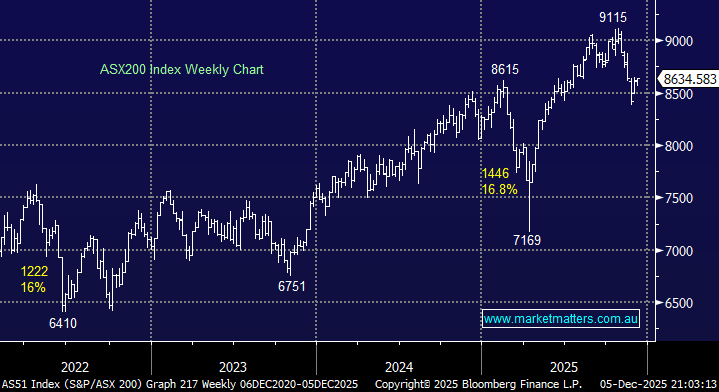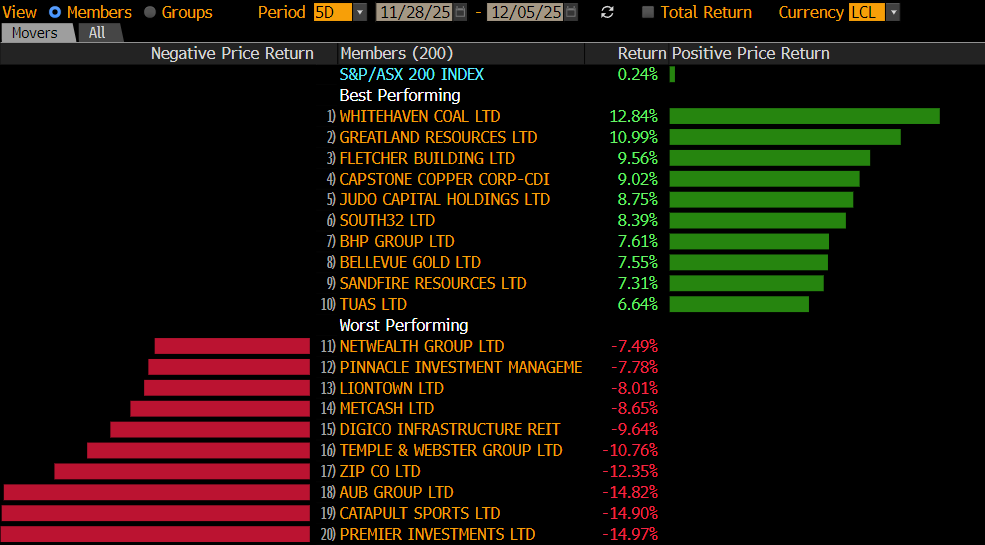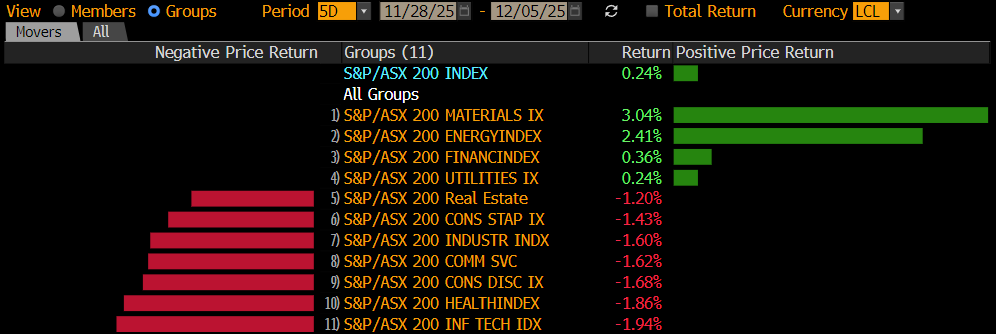Can Australian retail / discretionary spending catch up with the US? (BXB, APT, DMP, WEB, HVN, NCK)

The ASX200 had a mixed session yesterday, rallying all morning to be up 32-points around lunchtime prior to being sold off again in the afternoon – overall a very solid performance considering the Dow fell 193-points. The huge placement of Brambles shares (BXB) aftermarket is likely to have attributed to some of the afternoon selling, after all, a $393 million line of stock is no drop in the ocean and removes a lot of short-term buying from the market.
Over the last 5-days the local market has encountered reasonable selling / resistance above 6125, no great surprise following the last 5-weeks uninterrupted +7.3% rally, into the scary “sell in May & go away” timeframe.
- Short-term we can easily see an extension to the current pullback to ~6050, or another 0.9% lower.
Overnight markets were pretty quiet with the local market set to open a few points firmer - Westpac trading ex-dividend today 94c fully franked will take a few points from the ASX200.
- Medium term MM remains bullish targeting 6250 but the risk / reward is no longer compelling for the buyers.
Today’s report is going to look at Australia’s discretionary spending as we question if / when we can replicate the impressive performance in the US:
- Over the last 6-months the S&P500 is up +5.7% while the Consumer Discretionary sector up +13.1%, coming a close second to the Energy sector which has rallied +14.7%.
- Undoubtedly the US economy is way ahead of our own on its recovery since the GFC but markets look at least 6-months ahead, can the weakening Australian dollar help us join the global recovery of the consumer?
ASX200 Chart
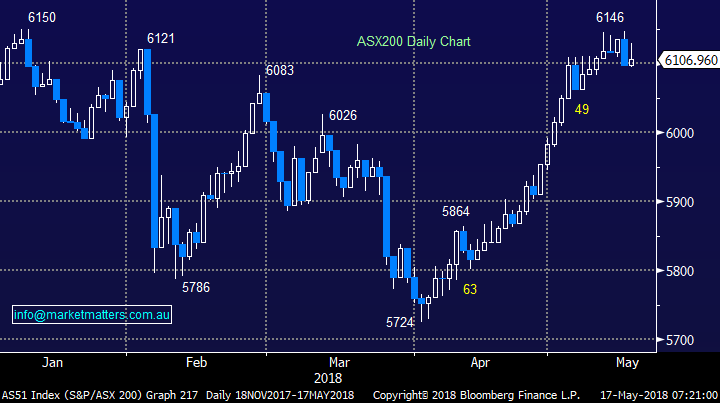
Brambles (BXB) $9.61
After the market closed last night, a huge line of 41.8 million Brambles shares was sold at $9.40, a small 2.2% discount to the market with rumours one fund manager was exiting their position.
- On balance we are neutral BXB but technically $8.50 would not surprise - a large whack natural buyers are now filled to the gunnels with the stock.
Brambles Chart
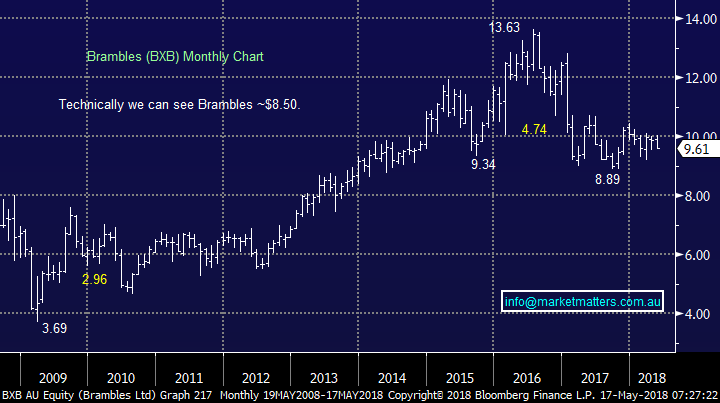
Australian Retail / Discretionary Sector
When we talk about consumer discretionary stocks its simply those companies that benefit from the spending of our “perceived free cash flow”, from a new TV, car upgrade to a nice holiday. Before the GFC it was commonplace to hear people saying they had re-mortgaged their house, or taken out a loan, to buy a nice, usually European new car but over recent years while retail spending has been steady the euphoric optimism around borrowing has been limited to the housing market which is now starting to cool.
Most Australians at the moment are becoming increasingly nervous about money / spending with the GFC still fresh in our minds + continual talk of rising interest rates and a housing ‘bubble’. There are 2 standout issues presently keeping the locks on our wallets:
1 Housing prices
It’s hard to open a newspaper at the moment without the discussion along the lines of “how far will house prices fall?”. Property prices are a huge part of Australian psych, a lot less of us play the share market compared to say our American friends but we all have an opinion on property. Again there are 2 issues within housing that concerns us:
- Prices are slipping, more so in some areas – a theme we have not experienced for a while. That said, prices are way above their levels of only 5-years ago which creates a good cushion. LVR’s are currently low across the sector – just ask GMA who have a shrinking pool of mortgage insurance customers.
- The papers continue to talk interest rates higher, this will take more money from our pockets and curtail any “reckless” purchases.
At MM we believe housing prices will soften over the next few years but not crash as we commonly hear. They simply rose too far, too fast, and now need time to consolidate. It can often be useful to use a real life example to highlight, and given I’ve recently sold and bought another property here’s my take (for what it’s worth).
We had held a house for 7 years which appreciated in value by $1.4m. We sold and bought within 2 months – right at the peak of the Sydney property market! We paid $1m more for the house we bought than the one we sold, however interest rates are low and we have locked in the bulk of the borrowings for 5 years at the low 4% mark – which I think is cheap. I’ve now got certainty for the next 5 years on repayments + my perception is that a 10% drop in Sydney house prices will impact me by 100k or in other words, 10% of the $1m differential between the two houses ( I appreciate the actual impact is more). Given the huge appreciation in recent years, this is a tolerable amount and importantly will not be a major impediment to my spending. (consumer spending is as much about feelings/perception/confidence) as anything else.
However, if we assume I’m an employee and as a consequence of tougher economic conditions I lose my job. This is when things can start to hurt and mortgage stress can come to fruition creating a ‘spiral effect’ on the economy. This suggests that the biggest issue / threat to housing is unemployment, and therefore the biggest threat to bank earnings is exactly the same. Watch unemployment metrics carefully over the coming month / years.
2 Australian debt levels
Looking more broadly, Australia’s household debt levels are now one of the highest in the world with our obsession with property the largest individual contributor - but we also do like a credit card. This level of household debt is unsustainable and we need to see a slow deleveraging process play out – which is in its infancy. For example we’re starting to see luxury car sales turning south.
The coming years
The important factor is when will we (as a nation) be back on top of our finances and start “treating” ourselves again. Remember stocks look at least 6-months ahead and once the trend becomes obvious its usually too late, especially on a risk / reward basis.
Due to the 2 important points touched on above many of our stocks in the discretionary space are cheap and are poised to rally strongly when the above mentioned debt levels start to fall as the slow deleveraging process takes shape. The important factor in all of this is employment. Servicing debt in the first instance and paying it down over time requires a job, and ultimately this will underpin a lot of what needs to take place economically in Australia. We’ve seen this in the US where unemployment has hit just 3.9% and consumer stocks are booming, even though house prices have cooled. In Australia, unemployment sits at 5.5% and is trending lower.
Australian unemployment rate
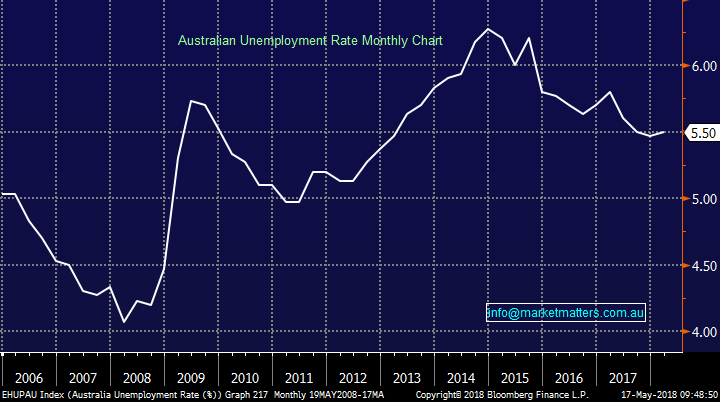
Australian v US Consumer Discretionary Index’s Chart
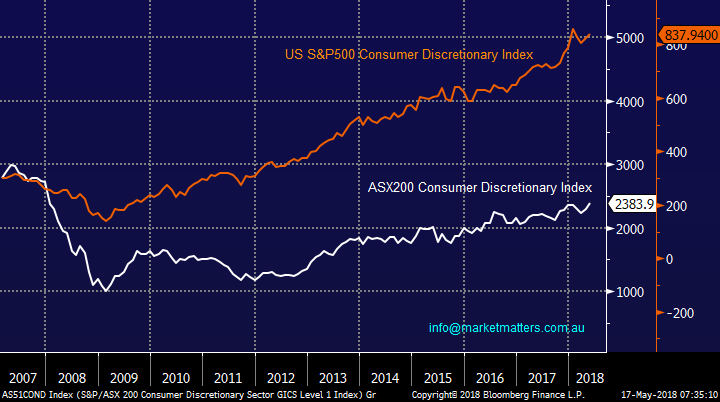
Interestingly, the weakness of the “little Aussie” battler illustrates perfectly the comparative strength of the US economy over ours. The RBA Cash Rate remains at its lowest level in history at 1.5% whereas the Fed has already hiked interest rates six times since late 2015, with another 2/3 more expected in 2018. For the first time in 17-years official interest rates in the US are above our own and the gap looks set to widen - back then the $A was at 48c!!
A weakening $A is good for our economy and exports but a lot of luxury overseas imports will go up in price, it’s always a 2-edged sword.
Australian Dollar Chart
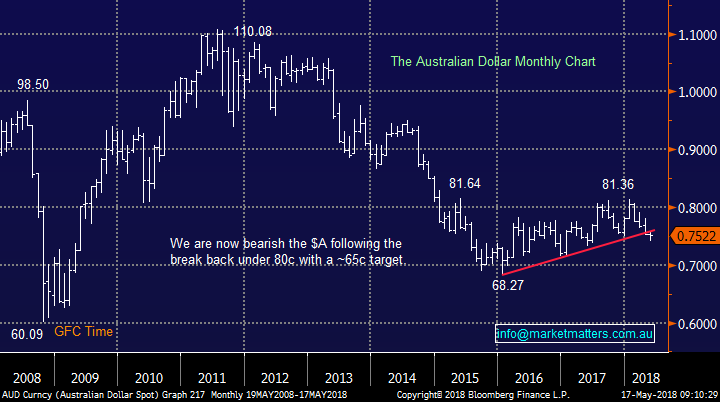
Although we think we’re ‘behind’ the US in terms of the recovery, discretionary stocks are cheap and are worth some consideration, but we’re not yet keen on the overall sector – we think it’s too early in the cycle.
Today we are going to look at 5 stocks that may provide an opportunity in 2018/9 for our discretionary $$’s.
1 Harvey Norman (HVN) $3.58
HVN has had a tough time of late along with most franchise models, its currently trading on a valuation of 10.8x this years estimated earnings while yielding an attractive 6.7% fully franked.
- Technically we like HVN for a bounce towards $4.50 but this is an aggressive play and we would run stops below $3.30, an 8% risk.
Harvey Norman (HVN) Chart
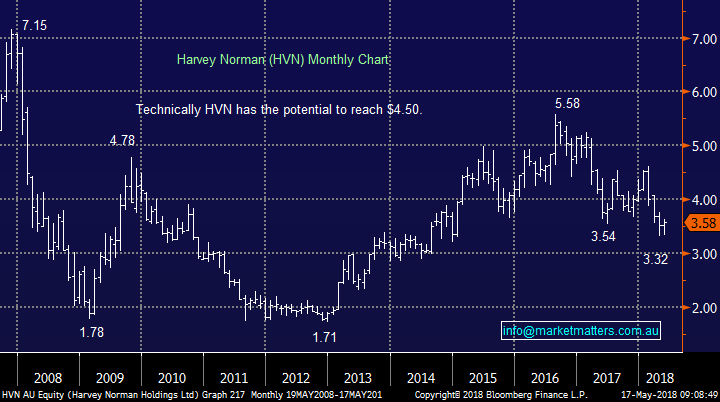
2 Nick Scali (NCK) $6.87
Nick Scali (NCK) remains in our Income Portfolio and it’s been a great example of how to stick to a core business, that you know / understand and make it work.
NCK is trading on 13.6x P/E while yielding 5.2% fully franked.
- The stock continues to look solid and we can see $8 on the horizon.
Nick Scali (NCK) Chart

3 Webjet (WEB) $12.01
Webjet (WEB) has rallied well this month and we maintain our ~$13.50 target, over 10% higher.
Store front rival Flight Centre (FLT) has soared 10% this month, to fresh all-time highs, which is a good sign that on-line based WEB can maintain its recent form.
- We remain bullish WEB targeting $13.50-$14.
Webjet (WEB) Chart
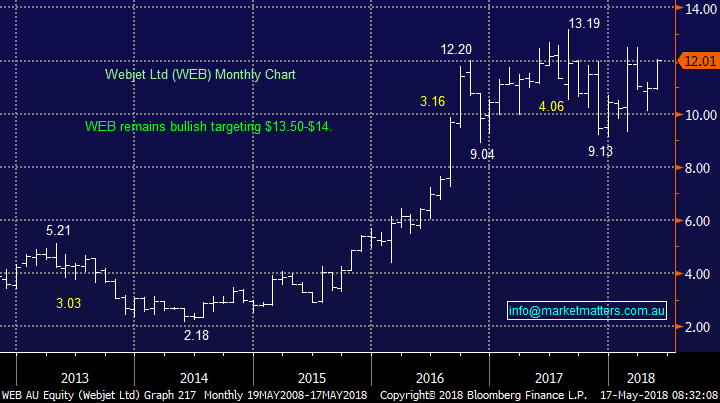
4 Domino’s Pizza (DMP) $44.37
DMP is another company suffering from the franchise stigma, and in most cases fully deserved!
This franchise pizza operator is not cheap trading on a valuation of 28.5x earnings while paying a 2.3% part franked yield.
- We are not a fan of DMP medium-term but can still see a pop to $50 / ~15%.
Domino’s Pizza (DMP) Chart
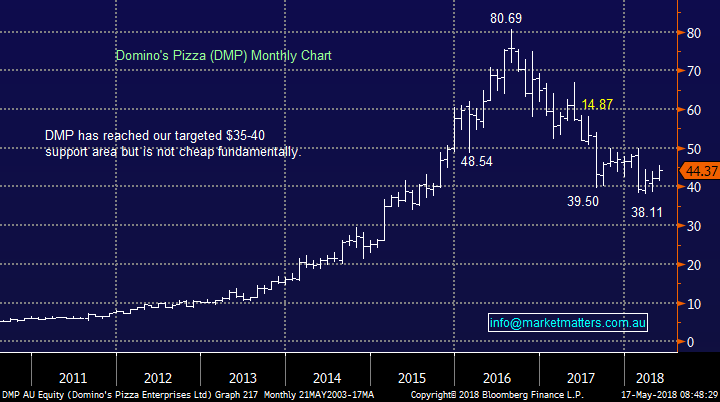
5 Afterpay (APT) $7.25
APT is the leading new on-line version of “layby” and its going gangbusters, recently announcing expansion into the US with some top quality hires to lead the growth. They “clip the ticket” on the sale and the purchaser pays later – Vanessa in our team loves it!
As a business they debatably benefit from us wanting to buy something but feeling a touch poor today.
- The stock looks to have an exciting future and good risk / reward buying below $7.
Afterpay (APT) Chart
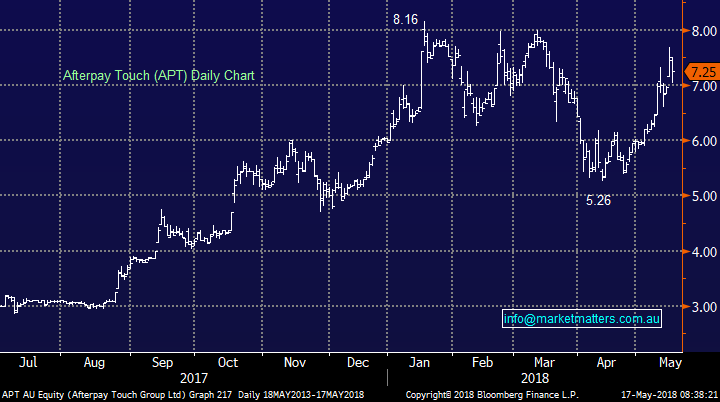
Conclusion
We think it’s too early to rush into the Australian discretionary spending sector as a whole.
However we currently like WEB, NCK and APT.
HVN and DMP are interesting more as trades but we are unlikely to be “players”.
Overseas Indices
No change, we are short-term bullish global indices targeting fresh all-time highs for most in the coming weeks / months:
- The US small cap index, Russell 2000, hit that milestone last night.
- Similarly the UK FTSE closed less than 1% below that level light.
US Russell 2000 Chart
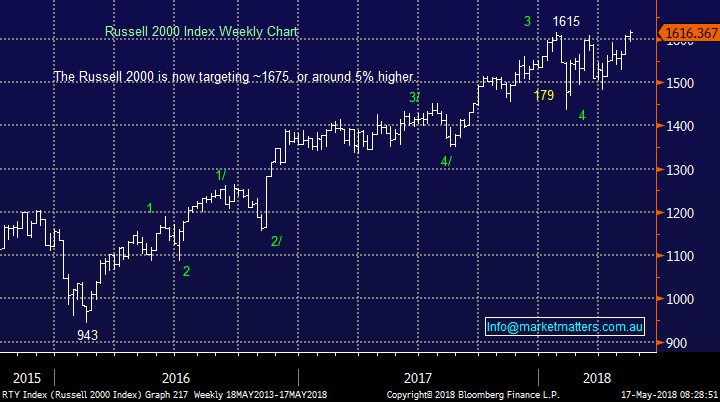
UK FTSE Chart
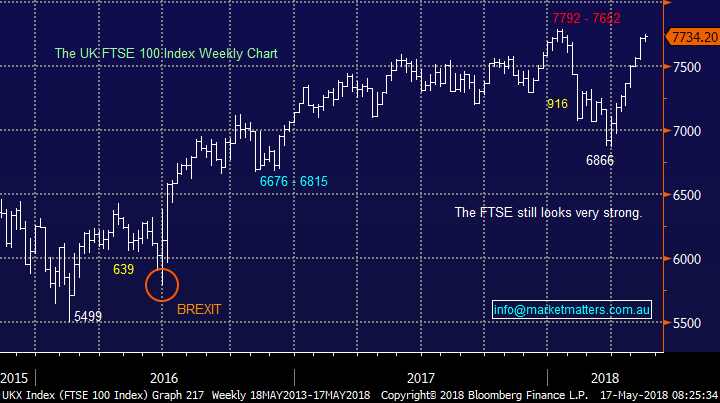
Overnight Market Matters Wrap
· The US closed marginally higher overnight, with the small cap index, Russell 2000 hitting an all-time high.
· Locally, investors will be watching the latest jobs data today with expectations of a slight fall in the unemployment rate from 5.5% to 5.4% with the creation of 25,000 new jobs.
· The June SPI Futures is indicating the ASX 200 to open marginally lower, testing the 6100 level this morning.
Have a great day!
James & the Market Matters Team
Disclosure
Market Matters may hold stocks mentioned in this report. Subscribers can view a full list of holdings on the website by clicking here. Positions are updated each Friday, or after the session when positions are traded.
Disclaimer
All figures contained from sources believed to be accurate. Market Matters does not make any representation of warranty as to the accuracy of the figures and disclaims any liability resulting from any inaccuracy. Prices as at 17/05/2018. 8.31AM
Reports and other documents published on this website and email (‘Reports’) are authored by Market Matters and the reports represent the views of Market Matters. The MarketMatters Report is based on technical analysis of companies, commodities and the market in general. Technical analysis focuses on interpreting charts and other data to determine what the market sentiment about a particular financial product is, or will be. Unlike fundamental analysis, it does not involve a detailed review of the company’s financial position.
The Reports contain general, as opposed to personal, advice. That means they are prepared for multiple distributions without consideration of your investment objectives, financial situation and needs (‘Personal Circumstances’). Accordingly, any advice given is not a recommendation that a particular course of action is suitable for you and the advice is therefore not to be acted on as investment advice. You must assess whether or not any advice is appropriate for your Personal Circumstances before making any investment decisions. You can either make this assessment yourself, or if you require a personal recommendation, you can seek the assistance of a financial advisor. Market Matters or its author(s) accepts no responsibility for any losses or damages resulting from decisions made from or because of information within this publication. Investing and trading in financial products are always risky, so you should do your own research before buying or selling a financial product.
The Reports are published by Market Matters in good faith based on the facts known to it at the time of their preparation and do not purport to contain all relevant information with respect to the financial products to which they relate. Although the Reports are based on information obtained from sources believed to be reliable, Market Matters does not make any representation or warranty that they are accurate, complete or up to date and Market Matters accepts no obligation to correct or update the information or opinions in the Reports.
If you rely on a Report, you do so at your own risk. Any projections are estimates only and may not be realised in the future. Except to the extent that liability under any law cannot be excluded, Market Matters disclaims liability for all loss or damage arising as a result of any opinion, advice, recommendation, representation or information expressly or impliedly published in or in relation to this report notwithstanding any error or omission including negligence.
To unsubscribe. Click Here


